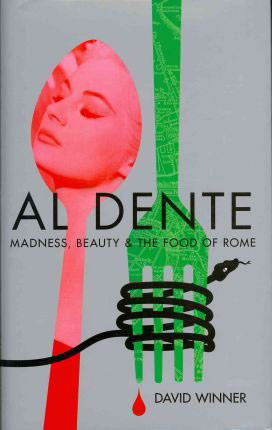I began this quirky, genre-defying book one sunny May morning and by the time I had got halfway through it, I was really enjoying myself. I had had no idea what to expect but was prepared for either a fatuous trawl through Rome’s “eateries” or for rapturous gushing about dining all’italiana being so much more “vibrant” than the drab way we do it at home. Al Dente is neither. And as I read on, I found myself making a mental list of things to check out next time I am in Rome. The ice cream place near Termini station, the statue of St Catherine of Siena, the Villa Farnesina (apparently Raphael’s frescoes are surrounded by borders of lewd fruit; I had never noticed. But now that I come to check, I do see something tumescent above the head of Hermes…). Maybe I won’t go to the trattoria with the Che Guevara poster, where the owner hates the bourgeoisie and imposes a necktie ban. Hatred and prohibition sit uneasily on this good-natured book.

At least, I thought it was good-natured. It purports to be about food and Rome, and yes, it is about those things, but not only, and sometimes only tangentially. It is about history, about film (Fellini and Antonioni), about art (Raphael, Caravaggio), about religion, about human relationships. Winner’s previous books have been about football and I expected the tone of Al Dente to be blokey. It isn’t. It’s amusing without being ho-ho. And Winner writes exceptionally well, with a wonderful, unpretentious, effective use of language. I enjoyed the image of ancient Rome as a horse carcase slowly being eaten by a buzzard. But it was at about this point that the book started to go wrong.
It wasn’t just the strange and rather surreal encounter in Caffè Greco with the elderly Frenchman calling himself Marie-Henry [sic] Beyle. Were we supposed to interpret him as the ghost of Stendhal? It wasn’t clear. No, it was the buzzard: a Christian buzzard. Aha. Soon enough it becomes apparent that Winner has a bone of his own to pick clean. First we learn that Michelangelo studied the kabbalah and came from “tolerant, more secular Florence” and then that Dante’s best friend was a Jewish poet, as if we need to claim these two great souls as righteous gentiles before getting started. But hang on. Savonarola outlawed Florentine-Jewish money-lending in 1495, when Michelangelo was twenty. How tolerant is that and how secular was Savonarola? And is Blech and Doliner’s theory about a subversive message encrypted in the Old Testament figures of the Sistine ceiling pseudo-science or an avenue for fruitful new research? Or both? Winner doesn’t help us to decide. It begins to feel perilously as though a good idea is being stretched too thin over too few pegs. We need more support before we can tread confidently on this kind of ground.
And what happened to the food angle? Or for that matter to the beauty promised in the subhead? They got lost. The sudden descent into Jewish-Christian polemic turns what was elegant, idiosyncratic fusion cuisine into a kind of unwholesome stodge, over-boiled and half-baked at the same time. What’s the point of it all? Winner suddenly sees everything in terms of black and white and the nuances of all those Fellini films he loves so much are lost. Which is a pity, because nuanced history is always more interesting.
But let’s return to the positive. On the back dust jacket there is a short blurb offering up the work to the reading public and modestly hoping that it gives them “something to chew on”. It certainly does. And when the indigestion passes I’ll be left with the feeling that I took something away, something useful: an insight into human attitudes as well as insider knowledge of where to find the best tiramisù on the planet. Both of them very valuable things.
Reviewed by Annabel Barber, contributing author of Blue Guide Rome (10th edition) and compiler of Blue Guide Literary Companion Rome .






